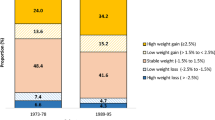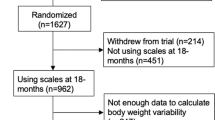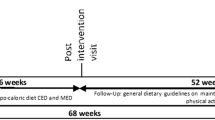Abstract
OBJECTIVE: To investigate the prevalence and predictors of weight maintenance over time in a large sample of young Australian women.
DESIGN: This population study examined baseline and 4 y follow-up data from the cohort of young women participating in the Australian Longitudinal Study on Women's Health.
SUBJECTS: A total of 8726 young women aged 18–23 y at baseline.
MEASURES: Height, weight and body mass index (BMI); physical activity; time spent sitting; selected eating behaviours (eg dieting, disordered eating, takeaway food consumption); cigarette smoking, alcohol consumption; parity; and sociodemographic characteristics.
RESULTS: Only 44% of the women reported their BMI at follow-up to be within 5% of their baseline BMI (maintainers); 41% had gained weight and 15% had lost weight. Weight maintainers were more likely to be in managerial or professional occupations; to have never married; to be currently studying; and not to be mothers. Controlling for sociodemographic factors, weight maintainers were more likely to be in a healthy weight range at baseline, and to report that they spent less time sitting, and consumed less takeaway food, than women who gained weight.
CONCLUSIONS: Fewer than half the young women in this community sample maintained their weight over this 4 y period in their early twenties. Findings of widespread weight gain, particularly among those already overweight, suggest that early adulthood, which is a time of significant life changes for many women, may be an important time for implementing strategies to promote maintenance of healthy weight. Strategies which encourage decreased sitting time and less takeaway food consumption may be effective for encouraging weight maintenance at this life stage.
This is a preview of subscription content, access via your institution
Access options
Subscribe to this journal
Receive 12 print issues and online access
$259.00 per year
only $21.58 per issue
Buy this article
- Purchase on Springer Link
- Instant access to full article PDF
Prices may be subject to local taxes which are calculated during checkout
Similar content being viewed by others

References
World Health Organization. Obesity, preventing and managing the global epidemic Report of the WHO Consultation on Obesity WHO: Geneva 1997
Flegal KM . The obesity epidemic in children and adults: current evidence and research issues Med Sci Sports Exerc 1999 31: S509–S514.
Mokdad A, Serdula M, Dietz W, Bowman B, Marks J, Koplan J . The spread of the obesity epidemic in the United States, 1991–1998 JAMA 1999 282 (6): 1519–1522.
Bennett N, Dodd T, Flatley J, Freeth S, Bolling K . Health survey for England 1993 HMSO: London 1995
Australian Bureau of Statistics. National Nutrition Survey: User's Guide, 1995 Catalogue no. 4801.0 Australian Bureau of Statistics: Canberra 1998
Bennett SA, Magnus P . Trends in cardiovascular risk factors in Australia: results from the National Heart Foundation's Risk Factor Prevalence Study, 1980–1989 Med J Am 1994 161: 519–527.
Hill JO, Melanson EL . Overview of the determinants of overweight and obesity: current evidence and research issues Med Sci Sports Exerc 1999 31 (11): S515–S521.
St Jeor ST, Brunner RL, Harrington ME, Scott BJ, Cutter GR, Brownell KD, Dyer AR, Foreyt JP . Who are the weight maintainers?? Obes Res 1995 3: S249–S259.
St Jeor ST, Brunner RL, Harrington ME, Scott BJ, Daugherty SA, Cutter GR, Brownell KD, Dyer AR, Foreyt JP . A classification system to evaluate weight maintainers, gainers and losers J Am Diet Assoc 1997 97: 481–488.
French SA, Jeffery RW, Folsom AR, Williamson DF, Byers T . Weight variability in a population-based sample of older women: reliability and intercorrelation of measures Int J Obes Relat Metab Disord 1995 19: 22–29.
Williamson DF, Kahn HS, Remington PL, Anda RF . The 10-year incidence of overweight and major weight gain in US adults Arch Intern Med 1990 150: 665–672.
Pasman WJ, Saris WM, Westerterp-Plantanga MS . Predictors of weight maintenance Obes Res 1999 7: 43–50.
US Department of Health and Human Services. Physical activity and health: a report of the Surgeon General Centers for Disease Control: Atlanta, GA 1996
Brown W, Dobson A, Mishra G . What is a healthy weight range for middle aged women?? Int J Obes Relat Metab Disord 1998 22: 520–528.
Parham ES . The context of weight changes: factors associated with weight changes in adult women J Am Diet Assoc 1988 88: 1539–1544.
Williamson DF . Descriptive epidemiology of body weight and weight change in US adults Ann Intern Med 1993 119: 646–649.
Brown WJ, Bryson L, Byles JE, Dobson AJ, Lee C, Mishra G, Schofield M . Women's Health Australia: recruitment for a national longitudinal cohort study Women Health 1998 28: 23–40.
National Health, and Medical, Research Council . Acting on Australia's weight: a strategic plan for the prevention of overweight and obesity AGPS: Canberra 1997
Lewis CE, Smith DE, Wallace DD, Williams OD, Bild DE, Jacobs DR . Seven-year trends in body weight and associations with lifestyle and behavioral characteristics in black and white young adults: the CARDIA Study Am J Pub Health 1997 87: 635–642.
Brown WJ, Mishra G, Lee C, Bauman A . Leisure time physical activity in Australian women: relationships with well being and symptoms Res Q Exerc Sport 2000 71: 201–216.
Jonas HA, Dobson AJ, Brown WJ . Patterns of alcohol consumption in young Australian women: socio-demographic factors, health-related behaviours and physical health Aust NZ J Pub Health 2000 24: 185–191.
Jackson M, Ball K, Crawford D . Beliefs about the causes of weight change in the Australian population Int J Obes Relat Metab Disord 2001 25: 1512–1516.
Brown WJ, Mishra G, Kenardy J, Dobson AJ . Relationships between body mass index and well-being in young Australian women Int J Obesity Relat Metab Disord 2000 24: 1360–1368.
French SA, Harnack L, Jeffery RW . Fast food restaurant use among women in the Pound of Prevention study: dietary, behavioural and demographic correlates Int J Obes Relat Metab Disord 2000 24: 1353–1359.
Flood V, Webb K, Lazarus R, Pang G . Use of self-report to monitor overweight and obesity in populations: some issues for consideration Aust NZ J Pub Health 2000 24: 96–99.
Wing R . Weight cycling in humans: a review of the literature Ann Beh Med 1992 14: 113–119.
Kajioka T, Tsuzuku S, Shimokata H, Sato Y . Effects of intentional weight cycling on non-obese young women Metabolism 2002 51 (2): 149–154.
Olson MB, Kelsey SF, Bittner V, Reis SE, Reichek N, Handberg EM, Merz CN . Weight cycling and high-density lipoprotein cholesterol in women: evidence of an adverse effect: a report from the NHLBI-sponsored WISE study. Women's Ischemia Syndrome Evaluation Study Group J Am Coll Cardiol 2000 36 (5): 1565–1571.
Australian Bureau of Statistics. National Health Survey: Users Guide Catalogue no. 4363.0 Australian Bureau of Statistics: Canberra 1995
Mokdad AH, Serdula MK, Dietz WH, Bowman BA, Marks JS, Kaplan JP . The continuing epidemic of obesity in the United States JAMA 2000 284 (13): 1605–1608.
Acknowledgements
The research on which this paper is based was conducted as part of the Australian Longitudinal Study on Women's Health (Women's Health Australia). We are grateful to the Australian Commonwealth Department of Health and Ageing for funding.
Kylie Ball is supported by a Public Health Postdoctoral Research Fellowship from the National Health and Medical Research Council, ID 136925. Dr David Crawford is supported by a Career Development Award funded jointly by the National Health and Medical Research Council and National Heart Foundation of Australia.
Author information
Authors and Affiliations
Corresponding author
Rights and permissions
About this article
Cite this article
Ball, K., Brown, W. & Crawford, D. Who does not gain weight? Prevalence and predictors of weight maintenance in young women. Int J Obes 26, 1570–1578 (2002). https://doi.org/10.1038/sj.ijo.0802150
Received:
Revised:
Accepted:
Published:
Issue Date:
DOI: https://doi.org/10.1038/sj.ijo.0802150
Keywords
This article is cited by
-
Is being childless associated with a woman’s risk of overweight and obesity? Results from a national longitudinal study
International Journal of Obesity (2023)
-
Examination of how food environment and psychological factors interact in their relationship with dietary behaviours: test of a cross-sectional model
International Journal of Behavioral Nutrition and Physical Activity (2019)
-
The relationship between body mass index, binge eating disorder and suicidality
BMC Psychiatry (2018)
-
Socioeconomic Position and Reproduction: Findings from the Australian Longitudinal Study on Women’s Health
Maternal and Child Health Journal (2018)
-
Objectively-assessed physical activity and weight change in young adults: a randomized controlled trial
International Journal of Behavioral Nutrition and Physical Activity (2017)


